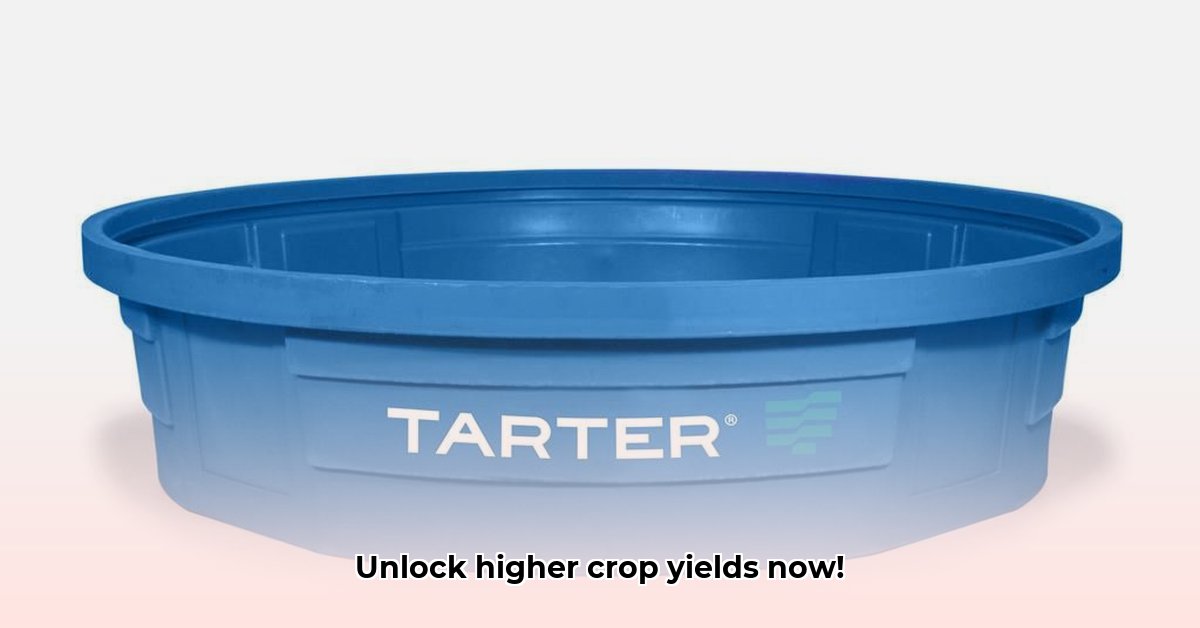
Water is the lifeblood of any successful farm, and efficient water management is crucial for sustainable and productive agriculture. Round stock tanks offer a reliable solution for storing and managing water resources, significantly impacting your crop yields and overall farm efficiency. This guide provides a comprehensive approach to selecting, installing, and maintaining a round stock tank for optimal water management. For more information on 12-foot options, check out this helpful resource: 12-foot stock tank.
Choosing the Right Round Stock Tank
Selecting the appropriate tank requires careful consideration of several factors. Your choice directly influences the longevity, efficiency, and overall cost-effectiveness of your water storage system. Don't rush this decision; it's an investment in your farm's future.
Determining Your Water Needs
Before you even begin shopping, accurately assess your farm's water requirements. Consider:
- Crop type and acreage: Different crops have varying water needs. A larger farm with thirsty crops will require a significantly larger tank than a smaller operation with drought-tolerant plants.
- Irrigation method: Drip irrigation systems typically require less water than overhead sprinklers. Understanding your irrigation method helps estimate the required tank capacity.
- Future expansion: Account for potential growth. A slightly larger tank can accommodate future expansion and unexpected dry spells.
A simple calculation, considering your irrigation needs and the frequency of watering, will help determine the necessary tank capacity. Is it cost-effective to purchase a larger tank initially, or would it be more prudent to invest in smaller tanks that can potentially be added later? Remember, accuracy here is paramount.
Comparing Tank Materials: Pros and Cons
Round stock tanks are available in various materials, each presenting unique advantages and disadvantages. The best choice depends on your budget, climate, and specific needs:
| Material | Pros | Cons |
|---|---|---|
| Galvanized Steel | Durable, readily available, relatively inexpensive. | Susceptible to rust and corrosion, especially in harsh climates. |
| Plastic (Polyethylene) | Lightweight, rust-proof, often less expensive, easier to handle. | Less durable than steel; may crack under extreme pressure or UV exposure. |
| Fiberglass | Extremely durable, resistant to corrosion and UV degradation. | More expensive than steel or plastic, may require specialized installation. |
For example, in a humid environment, a galvanized steel tank might require more frequent maintenance due to rust concerns. Conversely, a plastic tank is likely more suitable if you need easier maneuverability. The decision ultimately depends on your specific circumstances and priorities.
Budget Considerations: A Comprehensive Approach
Establish a realistic budget before purchasing. Factor in:
- Tank cost: Prices vary significantly based on material, size, and retailer.
- Delivery fees: Transportation costs can be substantial, especially for larger tanks.
- Installation expenses: Professional installation might be necessary, depending on the tank's size and your experience.
Failing to account fully for these costs can lead to unforeseen expenses, potentially delaying your project or compromising its quality. Transparency and comprehensive budgeting are critical.
Installing Your Round Stock Tank: A Step-by-Step Guide
Proper installation is crucial for ensuring the tank's stability, longevity, and efficient water delivery. Even experienced farmers can benefit from following a detailed procedure.
- Site Selection: Choose a level, well-drained area with easy access for filling and cleaning. Proximity to your irrigation system is also beneficial.
- Foundation Preparation: A strong, level base is essential. A concrete slab provides the most stability, but compacted gravel can be a viable alternative.
- Tank Placement: Carefully position the tank on the base; use a level to ensure perfect alignment.
- Plumbing Installation: Securely connect all inlets and outlets; professional assistance is recommended for complex plumbing systems.
- Leak Testing: Thoroughly test the tank for leaks after filling – promptly address any issues that arise.
Maintaining Your Round Stock Tank
Regular maintenance extends your tank's lifespan and maintains water quality. Think of this similar to maintaining any piece of farm equipment; regular checks are essential.
- Routine Inspections: Regularly check for any signs of damage, leaks, or rust. Promptly address minor issues to avoid larger problems.
- Cleaning: Periodically clean the tank to remove sediment and algae. This ensures water quality and prevents contamination.
- Water Treatment (Optional): Consider a filtration system to enhance water quality and reduce the risk of contamination, especially for livestock watering.
Integrating the Tank into Your Irrigation System
Your round stock tank shouldn't act as a standalone unit; it should be an integral part of your overall irrigation system.
- Gravity-Fed Systems: Ideal for smaller farms, gravity efficiently distributes water from an elevated tank.
- Pump-Assisted Systems: Necessary for distributing water over longer distances or to higher elevations; ensure correct pump sizing.
- Smart Irrigation Technology: Automated systems optimize water use based on weather patterns and crop needs.
Conclusion: Boosting Your Farm's Success
Investing in a well-chosen and properly maintained round stock tank significantly impacts the productivity and sustainability of your operation. Careful planning, meticulous installation, and diligent maintenance guarantee years of efficient water management and contribute to higher crop yields. Remember, thoughtful execution is integral to realizing the full potential of your investment.